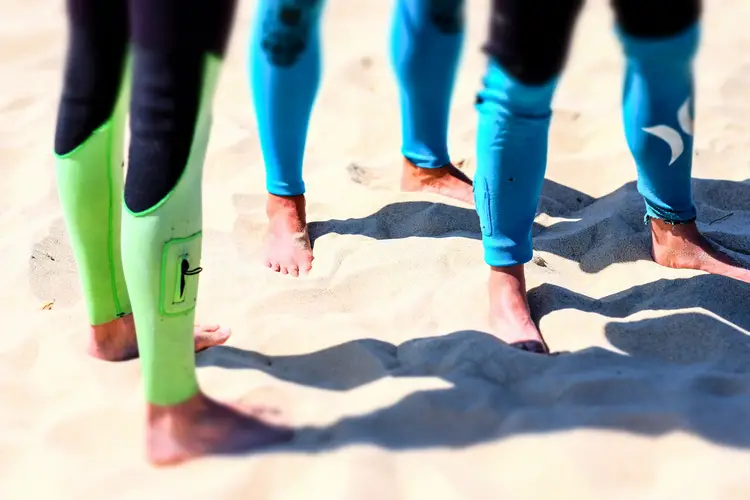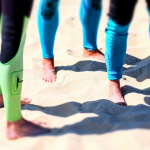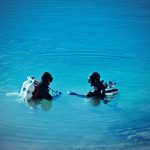
If you don’t have a wetsuit, there are still options available to help protect you and keep you comfortable while engaging in water activities.
Here are some suggestions on what to wear:
- Rashguard or Swim Shirt: A rashguard or swim shirt is a lightweight, quick-drying garment that provides protection against the sun, abrasions, and some insulation. It can be worn alone or layered with other clothing items.
- Board Shorts or Swim Trunks: Opt for board shorts or swim trunks made of quick-drying materials. These provide coverage and comfort while allowing freedom of movement in the water.
- Neoprene Accessories: Consider wearing neoprene accessories like neoprene booties or neoprene gloves. They provide some insulation and protection against abrasions.
- Layering: If the water is relatively warm, you can layer lightweight, quick-drying clothes such as leggings, tights, or a long-sleeved shirt. These layers can help trap a thin layer of water against your skin, which may provide some insulation.
- Wetsuit Alternatives: Some alternatives to wetsuits include spring suits or shorties. These are wetsuits with short arms and legs, providing some insulation while allowing more freedom of movement compared to full wetsuits.
- Consider the Weather Conditions: If you’re engaging in water activities in colder conditions, be sure to dress accordingly. Layering with thermal clothing, such as polypropylene or merino wool base layers, can provide additional warmth.
Remember, the choice of clothing depends on the water temperature, the duration of your activity, and your personal comfort level. Always prioritise safety and be aware of your surroundings.
If I am going diving I would probably avoid the dive if I didn’t have a wetsuit, unless the waters are really warm and above 30°C (86°F). Even when I scuba dive in Barbados when water temperatures are around 29.4°C (84.9°F) I dive in a 3mm wetsuit.
I have seen the diver master shiver when he comes up when he doesn’t where a wetsuit in these water temperatures in Barbados.
How can I stay warm without a wetsuit?
Staying warm without a wetsuit can be challenging, but there are a few strategies you can employ to help retain heat and stay comfortable in the water:
- Layering: Wear multiple layers of lightweight, quick-drying clothing. This helps create pockets of insulating air and provides some protection against the cold water. Consider wearing a rashguard or swim shirt as a base layer, followed by a long-sleeved shirt or sweater, and then a windproof outer layer if needed.
- Neoprene Accessories: Neoprene booties and gloves can help keep your extremities warm by providing insulation and protecting against the cold water. Consider wearing them to retain heat in your hands and feet.
- Swim Cap: Wearing a swim cap can help reduce heat loss from your head, which is a significant source of heat loss in the water. Opt for a neoprene or thermal swim cap if possible.
- Keep Active: Constant movement generates body heat. Engage in activities that keep you active in the water, such as swimming or water sports, to help generate warmth.
- Limit Exposure: Try to minimise the amount of time you spend in the water. Take breaks on land to warm up and allow your body to regain heat before returning to the water.
- Consider Water Temperature: Be aware of the water temperature and adjust your activities accordingly. If the water is too cold for extended periods without a wetsuit, it may be best to postpone your water activities until you have appropriate gear.
Remember, even with these strategies, the absence of a wetsuit means you’ll have less insulation and protection against the cold water. Always prioritise your safety and comfort, and be mindful of any signs of hypothermia or discomfort.
If you may be interested to learn more about liveaboard diving boats as a way to enjoy diving and to get more diving experience. If you are please take a look at the following window:
How can I swim in cold water without a wetsuit?
Swimming in cold water without a wetsuit requires careful consideration and preparation to ensure your safety and comfort.
Here are some tips to help you swim in cold water without a wetsuit:
- Acclimatise Gradually: Start by gradually exposing yourself to colder water temperatures. Begin with shorter swims and slowly increase the duration as your body adapts to the cold. This allows your body to adjust and build up tolerance to the lower temperatures.
- Swim with a Buddy: It’s always safer to swim in cold water with a buddy or have someone present onshore to monitor your activity. They can provide assistance if needed and help identify any signs of hypothermia or distress.
- Cold Water Entry and Exit: When entering the water, try to keep your exposure time to a minimum. Enter the water quickly and start swimming to generate body heat. When exiting, have warm clothes and towels ready to help you warm up promptly.
- Breathing Techniques: Practice controlled breathing techniques to help manage the shock of cold water on your system. Focus on deep and steady breaths to help regulate your body’s response to the cold.
- Cold Water Immersion: Before swimming, consider doing a short cold water immersion to help prepare your body. Gradually pour cold water over your body or submerge yourself up to your neck for a few minutes to help initiate the body’s cold response and increase tolerance.
- Use Hand and Foot Techniques: Concentrate on proper hand and foot techniques to maximise propulsion and maintain warmth. Effective hand and foot movements generate heat and help keep your extremities warmer.
- Monitor Your Body: Pay close attention to your body’s signals during the swim. If you experience numbness, tingling, excessive shivering, or dizziness, it’s crucial to exit the water and warm up immediately.
- Post-Swim Warm-up: After swimming in cold water, it’s essential to warm up quickly. Change into dry clothes, wrap yourself in warm towels or blankets, and consume warm fluids to help raise your core body temperature.
Remember, swimming in cold water without a wetsuit poses additional risks, and it’s crucial to assess your swimming ability, the water conditions, and your comfort level.
Always prioritise safety, know your limits, and be aware of the signs of hypothermia or cold-related injuries. If in doubt, it’s recommended to seek advice from experienced cold water swimmers or consider investing in appropriate cold water swimming gear.
Is it harder to swim without a wetsuit?
Swimming without a wetsuit can have both advantages and challenges compared to swimming with one. Here are some factors to consider:
Advantages of Swimming without a Wetsuit:
- Freedom of Movement: Without a wetsuit, you have greater freedom and range of motion in your limbs, allowing for more natural and unrestricted swimming strokes.
- Buoyancy Control: Wetsuits provide buoyancy, which can make it easier to stay afloat and maintain proper body position. Without a wetsuit, you have more control over your buoyancy and can fine-tune your body positioning in the water.
Challenges of Swimming without a Wetsuit:
- Cold Water Exposure: Cold water can have a significant impact on your swimming ability. It can cause muscle stiffness, reduced dexterity, and a decrease in overall performance. Without a wetsuit, you are more exposed to the cold water, which can affect your comfort and swimming efficiency.
- Heat Loss: Wetsuits provide insulation and help retain body heat. Swimming without a wetsuit increases heat loss from your body, especially in cold water, which can lead to faster heat depletion and potentially affect your endurance.
- Fatigue: Cold water and heat loss can contribute to faster fatigue during swimming. Your body may need to work harder to maintain its core temperature, which can lead to a quicker onset of fatigue compared to swimming with a wetsuit.
- Longer Warm-up and Recovery: Without the insulation provided by a wetsuit, it may take longer to warm up before swimming and recover afterward. You may need to spend additional time warming up your muscles and adjusting to the water temperature before starting your swim.
Ultimately, whether swimming without a wetsuit is harder or not depends on various factors, including water temperature, personal tolerance to the cold, swimming experience, and individual preferences. It’s important to assess these factors, consider your comfort level, and prioritise safety when deciding whether or not to swim without a wetsuit.
I hope you enjoyed this article about what should I wear if I don’t have a wetsuit?
I’d love to hear from you. Tell us about your adventures of diving and snorkelling. Please use the comments section below. Please also share your photos. Either from your underwater cameras or videos from your waterproof go-pro’s!
If this article hasn’t answered all of your questions. If you have more questions either about snorkelling or scuba diving (or specifically about what should I wear if I don’t have a wetsuit), please comment below with your questions.
There will also be many more articles about scuba and scuba diving safety tips (and on snorkelling too) for you to read and learn about this fabulous sport.




